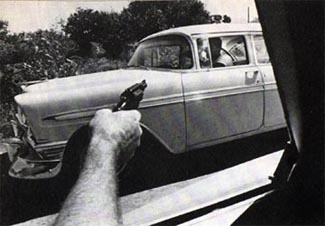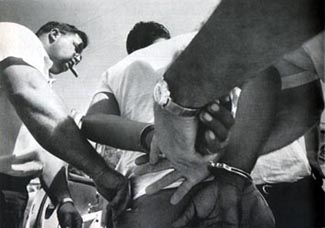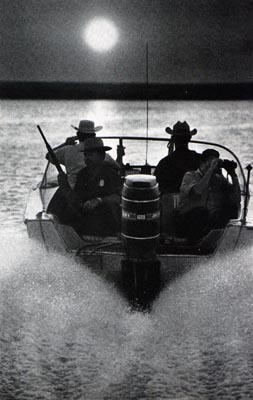"soon we will know"
Part of a larger issue on Marijuana
in Life magazine
Oct 31, 1969. 25-35

|
|
This bust was the climax of a bigtime smuggling case that began with an informer's tip : a quantity of marijuana was due to come across the Rio Grande at Laredo. Two nights later, agents hidden on the bank watched as several sacks were floated across in a raft made from two welded car hoods, then loaded into a car. They followed the car 150 miles to San Antonio where the driver turned it over to a buyer outside a supermarket. The buyer spotted the agents and sped off. At 50 mph the agents drew alongside (above), stopped him at gunpoint and clamped on the handcuffs (below). In the trunk of the car (right) they found $157,000 worth of pure Acapulco Gold.
|

|

|
The territory south of the border is chopped into fiefdoms by the families who, for a set price per pound, get the drugs into the U.S. The family heads, known by such names as "The Coyote," "The Possum," "The Painter" and "Martha," guard their domains jealously. The same families have offered murder contracts of up to $5,000 on certain agents and their informers. One agent today drives a souped-up Dodge formerly owned by an assassination squad sent to fulfill a contract. The agents got there first.
Occasionally agents persuade the "mule" (the man who drives drugs into the U.S.) to finger his buyer. Then the agent hides in the trunk of the car, with the goods, while the mule makes his delivery. Recently, one agent rode all the way to Pueblo, Colo., then leaped out with a sawed-off shotgun when the buyer opened the trunk.
Agents depend heavily on informers --their "snitch or "little finger"-- who ply a dangerous, $100-a-sqeal trade. Six were slain gangland-style in Tijuana last year. One informere recently called an agent to finger half an ounce of heroin that was coming across the bridge hidden in the air filter of a car. When inspectors searched the filter they found a note inside, carefully addressed to the agent by name. "Dear Mr. Kilman," it read. "You have just lost your little finger."

|
|
At sunset, customs agents, armed with shotguns scour the darkening waters of Falcon Lake, Texas --a favorite border crossing point for smugglers.
|


